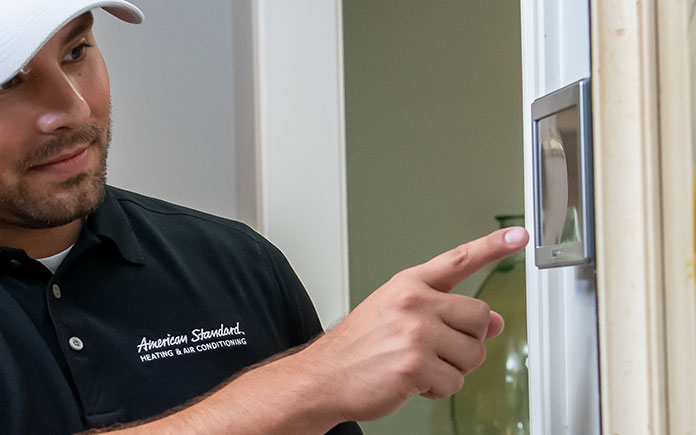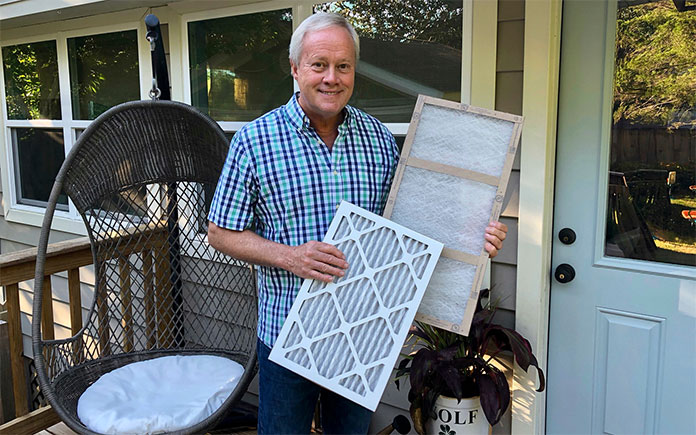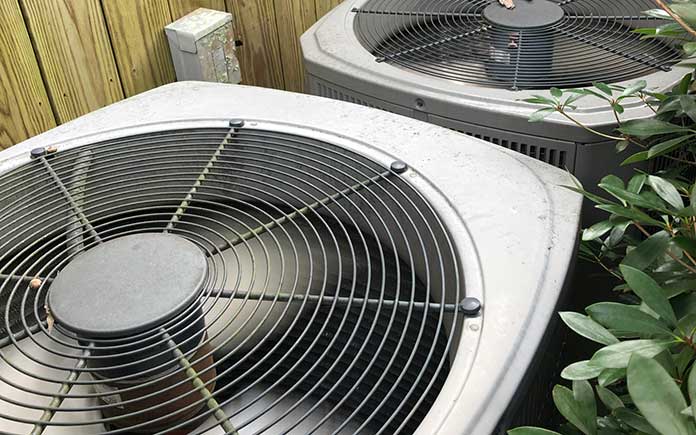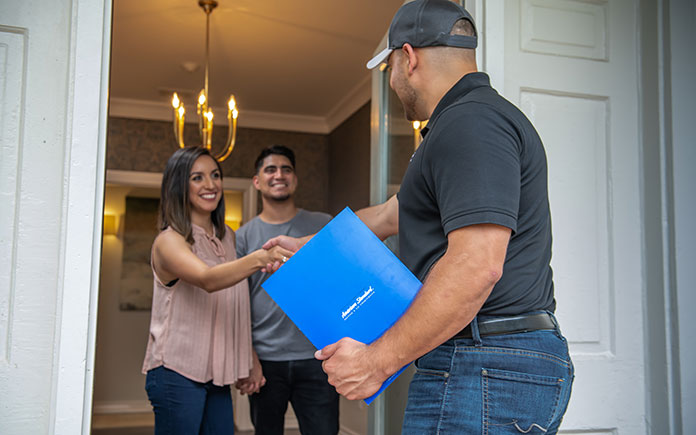
Few household chores pay off more than scheduling regular air conditioner maintenance, like changing your AC filter, cleaning the outdoor unit, checking for water leaks, and more.
A well-maintained air conditioning unit runs efficiently, uses less energy, and costs less to run. Best of all? A properly serviced system has fewer breakdowns and a longer life span.

What You Should Know About Air Conditioner Maintenance
As a homeowner, you can identify and fix common AC issues yourself. But you should leave technical assessments and repairs to properly trained, licensed professionals.
If you’re uncomfortable with performing any of the items on the list below, never hesitate to call a professional.
If you do handle some of the maintenance, always observe safety precautions. And, before you perform any work on your outdoor unit, shut down the power at your electrical box.
And now, for the tips!

1. Examine the Thermostat
This may be the easiest task for air conditioner maintenance. Just check your thermostat to make sure it works properly and keeps your home at the right temperature.
If you have an older mechanical thermostat, consider upgrading to a smart, programmable model like American Standard’s models.
A smart thermostat allows you to set the temperature higher when no one is home; it doesn’t turn the air conditioner off, just up. And it can cool the house down about 30 minutes before people arrive home for the evening.
By doing this, you’ll always have a comfortable home waiting for you. And you’ll save energy and money by not having your air conditioner running when no one is there.
Want to really maximize savings? Get a smart programmable thermostat that monitors and reports your energy use. Then, set daily schedules for cooling your home, test the results, and pocket the savings!

2. Clean or Replace Air Filters
Replacing your air conditioner’s filter (or cleaning it if you have a reusable filter) is one of the most important air conditioner maintenance chores. Do it every month during high-use seasons (like summer and winter) and once during the fall and spring. Air filters can be the source of many air conditioner-related issues and should be considered whenever you are cleaning an air conditioning unit.
You can find the air filter:
- Behind the return air grille on a wall or ceiling in a central room of the house.
- Inside the blower compartment of the air handler or furnace.
- In a slot on the side, bottom, or top of your furnace.
When the filter becomes full of dust, dirt, and allergen particles, airflow decreases. This makes your system work harder than it should. Air flowing through your system may also become dirtier and dustier, impacting your indoor air quality and triggering allergy and asthma symptoms for those living in the home.
Here’s the solution: Install a high-quality air filter. Inexpensive fiberglass air filters won’t capture smaller particles like pollen, bacteria, and viruses and must be changed every 30 days, or else you could end up having to disinfect your air conditioner.
But a pleated filter, depending upon its MERV rating, can capture those things and more. MERV stands for Minimum Efficiency Reporting Value. Why does the MERV rating matter? The higher the MERV rating, the more airborne pollutants the filter will capture.
Residential filters range from 1 MERV, such as what might be found in a window unit air conditioner, to 12 MERV, which is considered superior for residential use.
If you have family members with allergy and asthma problems, own pets, live in a dusty region, or have other similar indoor air quality challenges, consider upgrading to a filtration system that does more.
For example, American Standard’s AccuClean Whole-Home Air Filtration Systems removes up to 99.98% of these airborne pollutants and contains a reusable filter.
Installing or cleaning an air conditioner filter couldn’t be easier, and any homeowner can do it. Watch How to Change the Air Filter in Your Home for more information.

3. Clean the Outside Unit
Over time, leaves, dirt, and grass clippings build up outside the air conditioner unit; this decreases the system’s capacity and reduces airflow. It’s also why maintenance for the outside unit couldn’t be more important.
First, shut off power to the unit. You can do that at the service disconnect on your outdoor unit or at your home’s main breaker panel.
Then, use a garden hose to gently wash out the debris. Start at the top, with the hose at about a 45-degree angle, and work your way down.
Do not use a power washer — otherwise, you could damage the unit. And take care not to bend or damage the delicate fins on the coil.
Aluminum cooling fins on an air conditioner compressor must be straight for the unit to cool efficiently. If yours aren’t, here’s how to repair bent air conditioner compressor fins — it’s a Simple Solution to a common problem!
While you’re cleaning and making minor repairs on the outdoor unit, go ahead and trim any shrubs or other plants around your air conditioner. This will prevent them from impeding airflow to and from the unit.
4. Check Wiring and Components
Your air conditioner’s internal connections are crucial to its operation. What you don’t know about them could hurt your pocketbook from inefficient cooling, so it’s important to check the outdoor unit’s wiring at least once a year.

With the condenser unit’s power turned off, remove its access panel and look for signs of overheating. For instance, this could include melted insulation on wires and blackened or burned-looking wires.
Also, go ahead and check any electrical connections to make sure they are tight. If you own an electrical test meter, you can check the unit’s capacitors.
If you notice any problems and don’t feel comfortable correcting them yourself, call a local heating and air conditioning expert to do the work.
Of course, if you’re just not comfortable checking these parts yourself, that’s OK! Ask your local HVAC professional to include this in your bi-annual checkup.

5. Check the Condenser Unit’s Fan
Your air conditioner can’t cool your home very well if the condenser unit’s fan blades are in poor shape. That’s why it’s important to know their condition.
To do this, turn the power off to your air conditioning system and check the fan mounted on top of the outside condenser unit to make sure it’s still in good shape.
Replace the fan blades if there are any cracks or chips visible in one or more of the blades. You can purchase fan blades online from Amazon and air conditioner supply websites.
But first, make sure the blades fit your condenser unit. Most online stores have a list of compatible systems or will prompt you to type in the condenser’s model number to make sure it’s a match.
Also, if you have an older air conditioner unit, you may need to oil the fan motor bearings regularly.
Of course, if you’re not comfortable with this type of maintenance, just ask your local HVAC professional to include this in your bi-annual checkup.
6. Shade Your Outdoor Unit
Providing shade for your air conditioner’s outdoor unit can boost its efficiency. Plant trees or shrubs nearby, ensuring they are at least three feet away from the unit to allow for proper airflow from the condenser coils.
Shading helps the AC run cooler and puts less strain on it, extending its life span – which means providing shade is good preventative maintenance.
7. Clean Evaporator Coils
The evaporator coils inside your air handler can accumulate dust and grime over time, especially if you delay changing your AC filter.
This reduces your system’s cooling capacity and efficiency. To clean the coils – first, turn off the power to the unit.
Then, gently use a soft brush on a vacuum cleaner to remove the dust and spray the coils with a no-rinse coil cleaner. Allow the cleaner to foam and drain away dirt and debris.
8. Check for Water Leaks
Inspect your AC system regularly for signs of water leaks, which usually means you have a clogged condensate drain line.
Check the drain pan under the indoor unit and look for pooling water around the base of the indoor unit. If you notice leaks, flush the drain line with a mixture of water and white vinegar.
For severe clogs, you may need an HVAC professional to help you clear them.
9. Keep Vents Clean
Along with your whole home, vacuum and dust your supply and return air vents regularly to keep them free of obstructions.
Blocked vents make your AC work harder, consuming more energy and wearing out parts faster. Use the brush attachment on your vacuum to clean vent covers and wipe them down with a microfiber cloth.
Avoid obstructions over the vents, like placing furniture, curtains, or rugs over them.
10. Schedule Routine Duct Cleaning
Have your air ducts professionally cleaned every 3–6 years to remove accumulated dust, dander, and debris. Dirty ducts will circulate pollutants throughout your home and make your AC less efficient.
This could also lead to you and your family developing allergy symptoms, like running nose, congestion, watery eyes, etc.
During a cleaning, technicians will use powerful vacuums and long brushes to thoroughly clean and sanitize the full length of your ductwork. This improves indoor air quality and HVAC performance.

Call for Professional A/C Maintenance
Proper air conditioner maintenance can keep you comfortable during the hottest days of summer. In addition, it can save you energy and money.
Getting professional air conditioner tune-ups twice a year (once for heating and once for cooling) couldn’t be more important. Your furnace should be checked just before its winter use, and your air conditioner should be checked just before the hot summer months.
Your tune-up professional will lubricate and inspect all system parts for functionality. The HVAC technician will replace filters, clean out drain holes, check your refrigerant levels, and so forth.
Read our guide to what HVAC inspection costs to expect.
These routine check-ups are important to make sure your air conditioner is running at optimal performance and to help you avoid pesky air conditioner repair costs in the future.
Most important? Regular check-ups will ensure your air conditioner lasts for as many years as possible.
However, if you find yourself in need of an upgrade, consider a system that will not only meet your family’s comfort needs but also offer greater peace of mind with energy usage and billing expenses.
The American Standard Variable Speed cooling systems are a great option. They’re highly efficient air conditioners that will provide maximum comfort and can help lower operating costs and energy usage.
Learn more about air conditioners with HVAC basics, presented by American Standard HVAC.
Final Thoughts
Regular air conditioner maintenance is the best way to keep your home cool and comfortable during the hot summer months. Routinely doing these easy AC maintenance tips will help you catch small issues early and prevent more costly repairs down the line. Plus, it will keep your HVAC system running at peak performance. That said, you should also schedule yearly HVAC maintenance with a local HVAC contractor as well, so they can handle the more complex maintenance tasks.
Frequently Asked Questions
How often should I change my AC’s air filter?
Change your filter every 1–6 months, depending on usage, type of filter, and environmental factors like pets or allergies. Check it out monthly. If it looks dirty, switch it out with a new one.
Can I clean my AC unit myself or do I need a professional?
You can perform basic tasks like changing the filter and cleaning around the outdoor unit. However, for safety reasons, have an HVAC professional handle refrigerant, electrical components, and coil cleaning.
How long does a typical AC unit last?
With proper maintenance, a central air conditioner should last about 15–20 years. Neglecting upkeep could cut that lifespan in half. Consider its age, repair frequency, and efficiency when deciding to repair or replace it.
Further Information
Article Update Log






Leave a Reply